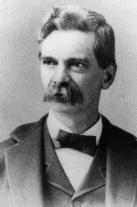1900
The western-style purse seine is first used in the Pacific herring
fishery, gradually replacing the Norwegian style of oar-propelled
seine boats.
President Theodore Roosevelt signs a law for construction of the second
Federal fisheries laboratory in the United States at Beaufort, N.C. Its
first director is Henry Van Peters Wilson, a University of North
Carolina professor.
1901
Charles A. Wilson begins summer work at the Woods Hole Laboratory, that
culminates in publication of "The Copepods of the Woods Hole Region
Massachusetts",- a standard reference in copepod biology.
The Commission employs a fish pathologlst on a part-time basis.
1902

The American Fisheries
Society places a granite monument to
Baird at the Woods Hole lab, where it remains today in a public
park.
The Nation's second Federal fisheries laboratory, in Beaufort, N.C.,
is occupied on May 26th. Though not yet complete, it provides a
laboratory, aquarium, office, 12 bedrooms, storerooms, etc.
1903
U.S. Fish Commission research activities are turned over to the
Department of Commerce and Labor Bureau of Fisheries.
By Act of February 14th, the U.S. Fish Commission and the Office of
the Commissioner of Fish and Fisheries are placed in the Department
of Commerce and Labor which is also created by the new Act. The
transfers take place on July 1st.
The formerly independent Fish Commission is named the U.S. Bureau of
Fisheries. The new Bureau retains the scientific responsibilities
of the Fish Commission and incorporates other fishery-related
functions: i.e. jurisdiction, supervision, and control over the fur seal
of Alaska are assumed from the Department of the Treasury.
David Starr Jordan is chosen to head a commlttee appointed by President
Theodore Roosevelt to investigate the causes for the decline in the
salmon fisheries of Alaska.
The first salmon-marking experiments are begun by Fred Chamberlain of
the Bureau of Fisheries in southeastern Alaska.
1904
One million whitefish, 100,000 brook trout, 53,000 lake trout, and
50,000 landlocked salmon eggs leave New York harbor for Argentina. Losses
are later reported as only 10% except for lake trout which began
hatching en route.
1905
The first Federal hatchey in Alaska is established on a lake at Yes
Bay in southeastern Alaska
In 1905, the fishing on New England banks was revolutionized by the
introduction of the otter trawl ... which met with a great deal of
opposition from many members of the industry--Herbert W. Graham,
writing in 1952.
1906
Bureau testing begins on a new wooden shipping case that holds 24 trays
of eggs. Each tray can hold 192,000 lake trout eggs.
The Sponge Act is passed as the first assertion of Federal authority to
manage marine fisheries. It set conservation rules for taking sponges
from the Gulf of Mexico and Straits of Florida
During a raid on the Pribilof Island (Alaska) seal rookeries, five
poachers are killed by bureau personnel acting in self defense, and a dozen
others are jailed
The Albatross sails on a lengthy research cruise to the Aleutian
Islands, Russia and Japan, making extensive biological collections and
discovering hundreds of new genera and fishes. Capt. LeRoy Mason
Garrett, U.S. Navy, thrown from the vessel in a violent storm is lost
at sea.
"The 1906 cruise of the United States Fisheries steamer Albatross had for its
especial object the investigation of the fish and fisheries of the Japanese
seas, where the ship spent most of the time. The journey out was made by way
of the Aleutian Islands, at several of which they stopped, Petropaulski,
Kamchatka, and the Kuril islands. They returned by way of Honolulu. As the
purpose of the expedition was the investigation of fish and marine
invertebrates, and the ship was usually occupied in work offshore, their
opportunities for collecting birds theyre reather limited, especially as their time
was largely taken up by their duties in connection with the marine work, as the
representative of the Bureau of Fisheries."
- Unalga Pass (24 May 1906?);
- Dutch Harbor/Unalaska (24-28 May 1906);
- off Bogoslof Islands (28 May 1906);
- Atka (30-31 May 1906);
- at Bower’s Bank (3 Jun 1906);
- off Semisopochnoi (?);
- Agattu (7-8 Jun 1906);
- off Semichi Islands (?);
- Attu (9-11 Jun 1906);
- Copper Island SIBERIA (13-14 Jun 1906);
- Bering Island SIBERIA (15-16 Jun 1906);
- Petropavlovsk/Avacha Bay KAMCHATKA (17-20 Jun 1906);
- off Cape Lopatka SIBERIA (?);
- Simushir KURILES (23-24 Jun 1906);
- Japanese waters and ports (27 Jun 1906-20 Sep 1906);
- Korsakoff SAKHALIN (24 Sep 1906);
- off Cape Patience/Terpenia SAKHALIN (27 Sep 1906);
- off southern KURILES (1 Oct 1906);
- Japanese waters and ports (4 Oct 1906-10 Nov 1906); and
- Honolulu (24 Nov 1906-2 Dec 1906).
From the paper entitled " The Birds Collected and
Observed during the Cruise of the United States Fisheries Steamer "Albatross"
in the North Pacific Ocean, and in the Bering, Okhotsk, Japan, and Eastern
Seas, from April to December, 1906"
1907
Rachel Louise Carson is born on May 27th. The famed conservationist,
author, marine biologist, and Bureau employee wrote "The Sea Around Us"
(1951), "Silent Spring" (1962), and other books that heightened public
environmental awareness.
The Albatross leaves San Francisco for a 2-1/2 year cruise to Midway,
Guam, Philippines, Borneo, Dutch East Indies, and Formosa.
1907-08
The second Federal hatchery in Alaska is built at Litnik Lake on
Afognak Island, near the site selected in 1889 by Livingston Stone and
on the resereve established earlier by Presidential proclamation.
1908

A.E. Verrill completes his study of the specimens collected
during the survey that began at the Woods Hole lab in 1871. The
project has formed the basis of hundreds of scientific papers on
invertebrates. The specimen collection includes some 2,000 species
taken from 3,000 locations in New England and is eventually given
to the Museum of Comparative Zoology at Harvard with duplicates in
the Peabody Museum of Yale University.

Home